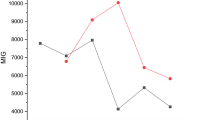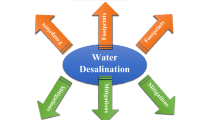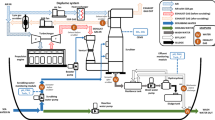Abstract
It is estimated that some 17 metric tons of residual oxidants (chlorine) are discharged into the enclosed coastal seawater of Kuwait on a daily basis from power-desalination plants alone. Alarmed by the unlimited number of reported cases of damage to marine aquatic systems due to chlorine discharge around the world, several alternatives were proposed to control such a massive discharge of residual oxidant into seawaters. Most of the proposed alternatives lacked the basic criteria necessary for their evaluation, justification, and then selection.
The objective of this article is to provide a conceptual approach that can be used to select a control measure for residual oxidant discharge in Kuwait coastal seawaters. This approach is based on state-of-the-art knowledge and the unique operational and environmental factors involved. A matrix system was designed whereby the cost of residual chlorine control alternative, its effectiveness, and environmental and public health impact, performance, and reliability in Kuwait can be compared and evaluated. The selection approach considered currently operating power plants in terms of their engineering design and material (cast iron or steel condensers), current operational conditions, operator's perception, acceptability, and projected problems associated with the environmental management of proposed modifications.
The proposed approach revealed that in Kuwait, conventinal chlorination was marginally superseded only by chlorination/dechlorination using SO2 and operation alteration using process optimization. The overall cost-effective assessment matrix classified other alternatives as worse than chlorination by various degrees.
Ozone and UV were found to be the worst and the least desirable alternatives for biofouling control of seawater in Kuwait.
In light of the available information on the consequences of the Gulf War on the marine environment, and the potential formation of additional halogenated organic compounds through the reaction of residual chlorine with the released petroleum hydrocarbons, it is essential to control residual chlorine discharged into the nearshore environment of Kuwait.
Similar content being viewed by others
Literature Cited
Ali, M. Y., and J. P. Riley. 1986. The distribution of halomethanes in coastal waters of Kuwait.Marine Pollution Bulletin 17:9.
Al-Hoti, B. N. 1987. Development of a model to predict biofouling control with chlorine in steam electric power plant condenser tubes. PhD Thesis. University of Miami, Miami, Florida.
Blume, W. J., and B. J. Kirk. 1980. Application of the Cathelco anti-fouling system for the control of marine growth in seawater inlets and condensers.In J. Jorden, A. Aitken, D. Burton and R. Gray (eds.), Condenser biofouling control. Ann Arbor Publisher, Ann Arbor, Michigan.
Bongers, L. H., D. T. Burton, L. H. Liden, and T. P. O'Conner. 1978. Bromine chlorine—an alternative biofouling control agent for cooling water treatment.In R. L. Jolley, H. Gorchev, and D. H. Hamilton (eds.), Water chlorination: Environmental impact and health effects, Vol. 2. Ann Arbor Publisher, Ann Arbor, Michigan.
Burton, D. T., and L. H. Liden. 1978. Biofouling control alternatives to chlorine for power plant cooling water systems: An overview.In R. L. Jolley, H. Gorchev, and D. H. Hamilton (eds.), Water chlorination: Environmental impact and health effects, Vol. 2. Ann Arbor Publisher, Ann Arbor, Michigan.
Charakalis, W. G., R. Bakke, and A. I. Yeh. 1985. Microbial fouling and its control: A phenomenological approach. EPRI CS-4339, Proceedings: Condenser biofouling control state-of-the-art symposium. Palo Alto, California. pp. 2–1 to 2–27.
Chen, C.-L., and H. B. Gan. 1981. Wastewater dechlorination state-of-the-art field survey and pilot studies. Municipal Environmental Research Laboratory of the EPA. 660/S2-81-169. Cincinnati, Ohio.
Chow, W. 1988. Targeted chlorination control condenser biofouling.EPRI Journal April/May:45–49.
Ecological Analysts, Inc., and SEAMOcean, Inc. 1983. A special permit application for the disposal of sewage sludge from twelve New York city water pollution control plants at the 12-Mile site. New York Department of Environmental Protection, New York.
Fava, J. A., W. J. Rue, P. Chrostowski, J. S. Ferris, and H. Plugge. 1985. Conceptual approach to evaluate alternatives to chlorination for biofouling control.In R. L. Jolley, R. J. Bull, W. P. Davis, S. Katz, M. H. Robert, and V. A. Jacobs (eds.), Water chlorination: environmental impact and public health effects, Vol. 5. Lewis Publishers, Chelsea, Michigan.
Garey, J. F., and R. DeHart. 1978. A comparison of the effectiveness of ozone and chlorine in controlling biofouling within condensers using fresh water as a coolant. Presented at aquatic applications of ozone workshop. Orlando, Florida. 29 October–1 November.
Garey, J. F. 1979. Biofouling control investigations: 18 month summary report. EPRI EA-1082. Palo Alto, California.
Garey, J. F. 1980. A review and update of possible alternatives to chlorination for controlling biofouling in cooling water systems of steams and steam electric generation stations.In R. L. Jolley (ed.), Water chlorination: Environmental impact and public health effects, Vol. 3. Ann Arbor Publisher, Ann Arbor, Michigan.
Garey, J. F., A. Fillipi, and D. Morris. 1985. The effectiveness of chlorine enhancers for maintaining tube cleanliness in condensers, using marine cooling water. EPRI CS-4339, Proceedings: Condenser biofouling control state-of-the-art symposium. Palo Alto, California.
Helz, G. R., A. D. Uhler, and R. Sugam. 1985. Dechlorination and trihalomethane yields.Bulletin of Environmental Contamination and Toxicology 34:497–503.
Hoveland, A. W. 1978. Effective condenser cleaning improves system heat rate.Power Engineering 82:49–50.
Kijak, P. J., and G. R. Helz. 1988. Fate of sulfur (IV) dechlorinating agents in natural waters: Effect of suspended sediments.Environmental Science and Technology 23:210.
Mattice, J. S., J. R. Trabalka, S. M. Adams, R. A. Faust, and R. L. Jolley. 1978. Evaluation of the potential of ozone as a power plant biocide. Oak Ridge National Laboratory. Publication 1219, TN, ORNL/TM-6459.
Mills, J. F. 1980. Bromine-chloride: An alternative to chlorine for the treatment of once-through cooling water.In J. Garey, R. Jorden, A. Aitken, D. Burton and R. Gray (eds.), Condenser biofouling control. Ann Arbor Publisher, Ann Arbor, Michigan.
Ministry of Electricity and Water. 1988. Statistical year book on electricity. Ministry of Electricity and Water, Kuwait, Kuwait.
Morris, D. W. 1983. Minimizing chlorine application consistent with effective macrofouling control: A pilot study of continuous low-level chlorination. Symposium on condenser macrofouling control technologies. EPRI Report CS-3343.
Moss, R. D., H. B. Flora II, R. A. Hilturner, and C. U. Seaman. 1980. Chlorine minimization/optimization for condenser biofouling control. Final EPA Report. EPA-600/7-80-143.
Moss, R. D., S. P. Gautney, and P. A. March. 1985. Targeted chlorination: Design and field studies.In R. L. Jolley, R. J. Bull, W. P. Davis, S. Katz, M. H. Robert, and V. A. Jacobs (eds.), Water chlorination: Environmental impact and public health effects, Vol. 5. Lewis Publisher Inc., Chelsea, Michigan.
Mussalli, Y. G., G. Hecker, M. Padmarabhan, J. Kasper, and W. Chow. 1985. Targeted chlorination.In EPRI proceedings: Condenser biofouling control state-of-the-art symposium. Palo Alto, California.
Platon, M., and T. D. Waite. 1985. A predictive model for destruction of biofilms with chlorine.In R. L. Jolley, (eds.), Water chlorination: Environmental impact and public health effects, Vol. 5. Lewis Publisher, Chelsea, Michigan.
Plugge, H. (1983). Issues in human health risk assessment.In R. L. Jolley et al. (eds.), Water chlorination: Environmental impact and public health effects, Vol. 4. Ann Arbor Publishers, Ann Arbor, Michigan.
Samhan, O. 1988. Strategic framework and master plan for fisheries development. Kuwait Institute for Scientific Research Report SPP-06A, Kuwait.
Sargent, A., and R. Lundy. 1984. Dechlorination technology manual. EPRI report CS-3758. Palo Alto, California.
Schumacher, P. D., and J. W. Lingle. 1980. Chlorine minimization studies at the Wisconsin Electric Power Co. Valley and Oak Creek power plants.In J. F. Garey, R. Jorden, A. Aitken, D. Burton, and R. Gray (eds.), Condenser biofouling control. Ann Arbor Publisher, Ann Arbor, Michigan.
Sopocy, D. H., A. F. Aschoff, and W. Chow. 1985. Assessment of dechlorination alternatives. EPRI Report CS-4339. Palo Alto, California.
Tan, C. S., S. Whitaker, and A. Berker. 1980. Design of dechlorination for power plant cooling stream.Journal of Water Pollution Control Federation 52:299–309.
Waite, T. D., R. M. Jorden, and R. Kawaratani. 1978. Evaluation of alternative chemical treatments for biofouling control in electric power facilities.In R. L. Jolley, H. Gorchev, and D. L. Hamilton (eds.), Ann Arbor Publishers, Ann Arbor, Michigan.
Waite, T. D., and J. R. Fagan. 1980. Summary of biofouling control alternatives.in J. Garey, R. Jorden, A. Aitken, D. Burton, and R. Gray (eds.), Condenser biofouling control. Ann Arbor Publishers, Ann Arbor, Michigan.
White, G. C. 1985. Handbook of chlorination. Van Norstrand Reinhold, New York.
Wilcox, P., and S. Denny. 1984. Effect of dechlorinating agents on the mutagenic activity of chlorinated water samples.In J. Garey, R. Jorden, A. Aitken, D. Burton, and R. Gray (eds.), Water chlorination: Environmental impact and public health effects. Ann Arbor Publishers, Ann Arbor, Michigan.
Wilde, W. E. 1986. Chlorination/dechlorination studies relating to proposed cooling towers for K and C reactors. DuPont De Nemours Report prepared for US Department of Energy. DE 87-003779.
Yu, H. H. S., G. A. Richardson, and W. H. Hedley. 1977. Alternatives to chlorination for control of condenser tube biofouling. US EPA, Washington, DC. EPA-600/7-77-030.
Author information
Authors and Affiliations
Rights and permissions
About this article
Cite this article
Khordagui, H.K. A conceptual approach to selection of a control measure for residual chlorine discharge in Kuwait bay. Environmental Management 16, 309–316 (1992). https://doi.org/10.1007/BF02400069
Issue Date:
DOI: https://doi.org/10.1007/BF02400069




